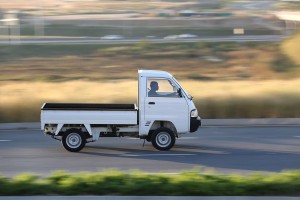Maruti Suzuki’s first mini-truck in the country has gone on sale, and offers a payload capacity of 740 kg.
Story by:
Bhushan Mhapralkar
Maruti Suzuki Super Carry went on sale in the state of Gujarat from September 01, 2016. The first mini-truck of the company – such trucks are termed as Small Commercial Vehicles (SCVs) in India, was commercially made available at an event at Ahmedabad in the presence of RS Kalsi, Executive Director (Marketing & Sales), Maruti Suzuki India, T Hashimoto, Executive Director (Marketing & Sales), Maruti Suzuki India, and CV Raman, Executive Director (Engineering), Maruti Suzuki India. RS Kalsi, at the launch, expressed that the company is targeting to fulfill the business needs of its customers. “Super Carry is a robust load carrying vehicle that offers high fuel efficiency,” he mentioned. Selling petrol engine commercial vehicles in the form of Omni Cargo, and later the Eeco Cargo in the sub-one tonne category, Maruti Suzuki has not been able to draw a crowd. The crowd puller was the Tata Ace, which in the form of a mini-truck kick started a new category of such vehicles in India in 2005. Much water has flown under the bridge since then, and the Tata Ace has grown to spring up many variants including a smaller 500-600 kg, 11.3 hp Ace Zip, and a bigger 1250 kg, 70 hp SuperAce Mint with a four-cylinder common-rail turbo-diesel engine. Mahindra overtime has responded with a slew of launches, the most recent being the Supro. The first SCV that Mahindra launched – the 850 kg Maxximo with a 25 hp common-rail turbo-diesel engine aimed squarely at the Ace. It claimed to boast of superior features; the products that followed, the Gio, Jeeto and the Supro, firmly embedded the Indian auto major in the SCV market.
For Maruti Suzuki, to find a place among such competitors may not be easy. It has not been easy for global players like Piaggio either, claim industry sources. For Maruti Suzuki, it may involve a lot of cash burn, they add. The 740 kg Super Carry, developing 75 Nm of peak torque at 2000rpm (hp figure not provided) from a 793 cc common-rail turbo-diesel engine, which is claimed to have been borrowed from the Celerio diesel and suitably tweaked, it is clear, is aiming squarely at the Tata Ace and the Mahindra Maxximo. It is priced at rupees-four lakh approximately, and will be available in multiple variants ranging from Rs. 2.28 lakh to rupees-five lakh according to company sources. The Super Carry platform is claimed to have been developed for India, Africa and other Asean countries. The SCV may have the advantage of using parts that are already employed in other models of the company, the fact is, the way a commercial vehicle operator may use his or her vehicle is a far cry from how a passenger vehicle is used. In a market where over 3.8 lakh LCVs were sold in FY2015-016, growth is expected to be in the range of 11 to 13 per cent. The Tata Ace continues to lead even as players like LML are said to be working towards foraying into the SCV market. The high level of indigenisation the Super Carry is claimed to posses will definitely help Maruti Suzuki, claim industry experts. They also point at the company’s deep pockets, and the ability to export. In India, they add, it may be a uphill journey despite the company boasting of a network of 3200 service centres. Sources close to the company are known to have said that the Super Carry waill be sold through an independent channel like it is selling its premium passenger vehicles through the Nexa channel. A separate channel will help to establish a CV product portfolio, and especially if Maruti Suzuki were to pursue a goal of introducing more models in the future.
Maruti Suzuki sources are not off the mark when they speak about targeting the last mile connectivity needs of businesses like ecommerce, and delivery of diverse nature of goods including medicines, vegetables, fruits, etc. It is certain that Maruti Suzuki has done its calculations diligently. The fact is, there is so much to learn in a complex market like India where it is not just about uptime, but also the ability to offer a product that assures superior levels of functionality at super low prices. The plan to introduce the Super Carry, which is sold in the African markets with a 1.2-litre petrol engine borrowed from the Eeco, in three cities (Ahmedabad, Kolkata and Ludhiana) is already being executed. The passenger car leader in the country will soon have a presence in three states that it is launching the Super Carry in. On the anvil next, is a plan to increase the reach to five states, and go pan-India by the end of 2017. On the cautious side, Kalsi is known to express that they would like to first understand customer expectations and then consider any addition to the product portfolio. He is also known to have expressed that they are focussing on good load carrying capacity. It is likely that he is pointing at overloading. In the urban context of use, SCVs may be subjected to overloading. They may be also amounted to rough use. The market, as Mahindra’s new offerings have indicated, is ready to look at new products. Influencing a migration is however a long drawn process, the success of which will be evident only over a period of time. CV’s request for a drive and ‘feel’ of the Super Carry is yet to find favour with the company.





















